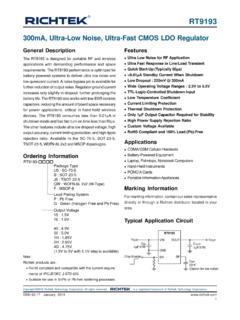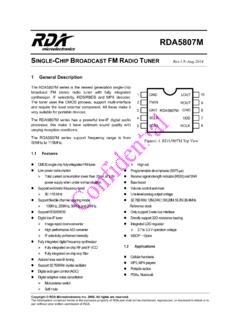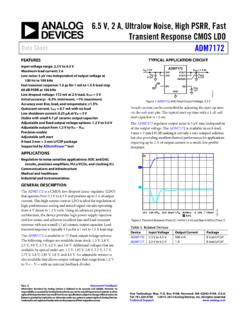Transcription of MCP1702 250 mA Low Quiescent Current LDO Regulator
1 2010 Microchip Technology 1 MCP1702 Features: A Quiescent Current (typical) Input Operating Voltage Range: to 250 mA Output Current for Output Voltages 200 mA Output Current for Output Voltages < Low Dropout (LDO) Voltage- 625 mV typical @ 250 mA (VOUT = ) Typical Output Voltage Tolerance Standard Output Voltage Options:- , , , , , , , , Output Voltage Range to in Increments (50 mV increments available upon request) Stable with F to 22 F Output Capacitor Short-Circuit Protection Overtemperature ProtectionApplications: Battery-powered Devices Battery-powered Alarm Circuits Smoke Detectors CO2 Detectors Pagers and Cellular Phones Smart Battery Packs Low Quiescent Current Voltage Reference PDAs Digital Cameras Microcontroller Power Solar-Powered Instruments Consumer Products Battery Powered Data LoggersRelated Literature: AN765, Using Microchip s Micropower LDOs , DS00765, Microchip Technology Inc.
2 , 2002 AN766, Pin-Compatible cmos Upgrades to Bipolar LDOs , DS00766, Microchip Technology Inc., 2002 AN792, A Method to Determine How Much Power a SOT-23 Can Dissipate in an Application , DS00792, Microchip Technology Inc., 2001 Description:The MCP1702 is a family of cmos low dropout (LDO)voltage regulators that can deliver up to 250 mA ofcurrent while consuming only A of quiescentcurrent (typical). The input operating range is specifiedfrom to , making it an ideal choice for two tosix primary cell battery-powered applications, 9 Valkaline and one or two cell MCP1702 is capable of delivering 250 mA withonly 625 mV (typical) of input to output voltagedifferential (VOUT= ). The output voltage toleranceof the MCP1702 is typically at +25 C and 3%maximum over the operating junction temperaturerange of -40 C to +125 C.
3 Line regulation is at +25 voltages available for the MCP1702 range to The LDO output is stable when using only1 F of output capacitance. Ceramic, tantalum oraluminum electrolytic capacitors can all be used forinput and output. Overcurrent limit andovertemperature shutdown provide a robust solutionfor any options include the SOT-23A, SOT-89-3, Types132 VINGND VOUTMCP1702123 VINGNDVOUTMCP17023-Pin SOT-23A3-Pin SOT-89 VIN3-Pin TO-9212 VOUTVINGNDB ottomView3250 mA Low Quiescent Current LDO RegulatorMCP1702DS22008E-page 2 2010 Microchip Technology Block DiagramsTypical Application Circuits+- MCP1702 VINVOUTGND+VINE rror AmplifierVoltageReferenceOvercurrentOver temperatureMCP1702 VINCIN1 F CeramicCOUT1 F mAGNDVOUT9 VBattery+ 2010 Microchip Technology CHARACTERISTICSA bsolute Maximum Ratings + inputs and outputs.
4 ( ) to (VIN+ )Peak Output Current ..500 mAStorage temperature ..-65 C to +150 CMaximum Junction Temperature .. 150 CESD protection on all pins (HBM;MM) 4kV; 400V Notice: Stresses above those listed under MaximumRatings may cause permanent damage to the device. This isa stress rating only and functional operation of the device atthose or any other conditions above those indicated in theoperational listings of this specification is not to maximum rating conditions for extended periodsmay affect device CHARACTERISTICSE lectrical Specifications: Unless otherwise specified, all limits are established for VIN = VOUT(MAX) + VDROPOUT(MAX), Note 1, ILOAD = 100 A, COUT = 1 F (X7R), CIN = 1 F (X7R), TA = +25 type applies for junction temperatures, TJ of -40 C to +125 C. (Note 7)ParametersSymMinTypMaxUnitsConditionsI nput / Output CharacteristicsInput Operating 1 Input Quiescent CurrentIq AIL = 0 mAMaximum Output CurrentIOUT_mA250 mAFor VR mAFor VR < , VIN mAFor VR < , VIN mAFor VR < , VIN mAFor VR < , VIN Short Circuit CurrentIOUT_SC 400 mAVIN = VIN(MIN) (Note 1), VOUT = GND, Current (average Current ) measured 10 ms after short is Voltage + VR+ VR+ CustomVOUT Temperature CoefficientTCVOUT 50 ppm/ CNote 3 Line Regulation VOUT/(VOUTX VIN) + (VOUT(MAX) + VDROPOUT(MAX)) VIN , (Note 1)Load Regulation + = mA to 250 mA for VR = mA to 200 mA for VR , VIN = (Note 4)Note 1:The minimum VIN must meet two conditions: VIN and VIN VOUT(MAX) + VDROPOUT(MAX).
5 2:VR is the nominal Regulator output voltage. For example: VR = , , , , , , , , or The input voltage VIN = VOUT(MAX) + VDROPOUT(MAX) or VIN = (whichever is greater); IOUT = 100 A. 3:TCVOUT = (VOUT-HIGH - VOUT-LOW) *106 / (VR * Temperature), VOUT-HIGH = highest voltage measured over the temperature range. VOUT-LOW = lowest voltage measured over the temperature :Load regulation is measured at a constant junction temperature using low duty cycle pulse testing. Changes in output voltage due to heating effects are determined using thermal regulation specification :Dropout voltage is defined as the input to output differential at which the output voltage drops 2% below its measured value with an applied input voltage of VOUT(MAX) + VDROPOUT(MAX) or , whichever is :The maximum allowable power dissipation is a function of ambient temperature, the maximum allowable junction temperature and the thermal resistance from junction to air ( , TA, TJ, JA).
6 Exceeding the maximum allowable power dissipation will cause the device operating junction temperature to exceed the maximum 150 C rating. Sustained junction temperatures above 150 C can impact the device :The junction temperature is approximated by soaking the device under test at an ambient temperature equal to the desired Junction temperature. The test time is small enough such that the rise in the Junction temperature over the ambient temperature is not 4 2010 Microchip Technology Voltage(Note 1, Note 5)VDROPOUT 330650mVIL = 250 mA, VR = 525725mVIL = 250 mA, VR < 625975mVIL = 250 mA, VR < 7501100mVIL = 250 mA, VR < mVVR < , See Maximum Output Current ParameterOutput Delay TimeTDELAY 1000 sVIN = 0V to 6V, VOUT = 90% VR RL = 50 resistiveOutput NoiseeN 8 V/(Hz)1/2IL = 50 mA, f = 1 kHz, COUT = 1 FPower Supply Ripple Rejection RatioPSRR 44 dBf = 100 Hz, COUT = 1 F, IL = 50 mA, VINAC = 100 mV pk-pk, CIN = 0 F, VR= Shutdown ProtectionTSD 150 CDC CHARACTERISTICS (CONTINUED)Electrical Specifications.
7 Unless otherwise specified, all limits are established for VIN = VOUT(MAX) + VDROPOUT(MAX), Note 1, ILOAD = 100 A, COUT = 1 F (X7R), CIN = 1 F (X7R), TA = +25 type applies for junction temperatures, TJ of -40 C to +125 C. (Note 7)ParametersSymMinTypMaxUnitsConditionsN ote 1:The minimum VIN must meet two conditions: VIN and VIN VOUT(MAX) + VDROPOUT(MAX).2:VR is the nominal Regulator output voltage. For example: VR = , , , , , , , , or The input voltage VIN = VOUT(MAX) + VDROPOUT(MAX) or VIN = (whichever is greater); IOUT = 100 A. 3:TCVOUT = (VOUT-HIGH - VOUT-LOW) *106 / (VR * Temperature), VOUT-HIGH = highest voltage measured over the temperature range. VOUT-LOW = lowest voltage measured over the temperature :Load regulation is measured at a constant junction temperature using low duty cycle pulse testing.
8 Changes in output voltage due to heating effects are determined using thermal regulation specification :Dropout voltage is defined as the input to output differential at which the output voltage drops 2% below its measured value with an applied input voltage of VOUT(MAX) + VDROPOUT(MAX) or , whichever is :The maximum allowable power dissipation is a function of ambient temperature, the maximum allowable junction temperature and the thermal resistance from junction to air ( , TA, TJ, JA). Exceeding the maximum allowable power dissipation will cause the device operating junction temperature to exceed the maximum 150 C rating. Sustained junction temperatures above 150 C can impact the device :The junction temperature is approximated by soaking the device under test at an ambient temperature equal to the desired Junction temperature.
9 The test time is small enough such that the rise in the Junction temperature over the ambient temperature is not significant. 2010 Microchip Technology 5 MCP1702 TEMPERATURE SPECIFICATIONS (Note 1)ParametersSymMinTypMaxUnitsConditionsT emperature RangesOperating Junction Temperature RangeTJ-40+125 CSteady StateMaximum Junction TemperatureTJ +150 CTransientStorage Temperature RangeTA-65+150 CThermal Package Resistance (Note 2)Thermal Resistance, 3L-SOT-23A JA 336 C/WEIA/JEDEC JESD51-7FR-4 4-Layer Board JC 110 C/WThermal Resistance, 3L-SOT-89 JA C/WEIA/JEDEC JESD51-7FR-4 4-Layer Board JC 100 C/WThermal Resistance, 3L-TO-92 JA C/W JC C/WNote 1:The maximum allowable power dissipation is a function of ambient temperature, the maximum allowable junction temperature and the thermal resistance from junction to air ( , TA, TJ, JA).
10 Exceeding the maximum allowable power dissipation will cause the device operating junction temperature to exceed the maximum 150 C rating. Sustained junction temperatures above 150 C can impact the device :Thermal Resistance values are subject to change. Please visit the Microchip web site for the latest packaging 6 2010 Microchip Technology PERFORMANCE CURVESNote: Unless otherwise indicated: VR = , COUT = 1 F Ceramic (X7R), CIN = 1 F Ceramic (X7R), IL = 100 A,TA = +25 C, VIN = VOUT(MAX) + VDROPOUT(MAX).Note: Junction Temperature (TJ) is approximated by soaking the device under test to an ambient temperature equal to the desired junctiontemperature. The test time is small enough such that the rise in Junction temperature over the Ambient temperature is not 2-1: Quiescent Current vs. Input 2-2: Quiescent Current 2-3: Quiescent Current 2-4:Ground Current vs.

















